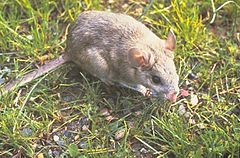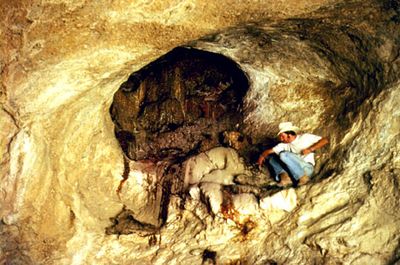Pack rat facts for kids
Quick facts for kids Pack ratsTemporal range: Late Miocene – Recent
|
|
|---|---|
 |
|
| Neotoma cinerea | |
| Scientific classification | |
| Kingdom: | |
| Phylum: | |
| Class: | |
| Order: | |
| Superfamily: | |
| Family: | |
| Subfamily: | |
| Tribe: |
Neotomini
|
| Genus: |
Neotoma
Say & Ord, 1825
|
A pack rat or packrat, also called a woodrat, can be any of the species in the rodent genus Neotoma. Pack rats have a rat-like appearance with long tails, large ears and large black eyes. Compared to deer mice, harvest mice and grasshopper mice, pack rats are noticeably larger and are usually somewhat larger than cotton rats.
Contents
Range and distribution
Woodrats reach their greatest diversity in the deserts of the western United States and northern Mexico. Several species are also found in the deciduous forest of the east coast, juniper woodlands in the southwest, oak woodlands along the coastal western United States and in the Sonoran Desert, and in the forest and rocky habitats of the western United States and western Canada.
Habitat
Each species of pack rat is generally restricted to a given type of habitat within its range. Pack rats live anywhere from low, hot, dry deserts to cold, rocky slopes above timberline. Pack rats build complex houses or dens made of twigs, cactus joints, and other materials. These contain several nest chambers, food caches, and debris piles. Dens are often built in small caves or rocky crevices, but when close by human habitations, woodrats will opportunistically move into the attics and walls of houses. Some Neotoma species, such as the white-throated woodrat (N. albigula), use the bases of prickly pear or cholla cactus as the sites for their homes, using the cactus' spines for protection from predators. Others, like the desert woodrat (N. lepida) will build dens around the base of a yucca or cactus, such as jumping and teddy-bear chollas. The largest species, Neotoma cinerea, has a bushy, almost squirrel-like tail. Bushy-tailed woodrats Neotoma cinerea occupy a range of habitats from boreal woodlands to deserts. They are cliff-dwellers and are often found on isolated, high-elevation exposed boulder areas under a variety of temperature and moisture conditions. They require adequate shelter among the rocks, though they are occasionally found inhabiting abandoned buildings as well.
Characteristics
Behavior
Pack rats are nest builders. They use plant material such as twigs, sticks, and other available debris. They are particularly fond of shiny objects. A peculiar characteristic is that if they find something they want, they will drop what they are currently carrying—for example, a piece of cactus—and "trade" it for the new item. They can also be quite vocal and boisterous. Getting into everything from attics to car engines, stealing their ‘treasures’, damaging electrical wiring, and creating general noisy havoc can easily cause them to become a nuisance.
Diet
Bushy-tailed woodrats feed primarily on green vegetation, twigs, and shoots. Mexican woodrats eat seeds, fruits, acorns, and cactus.
Size
Adult bushy-tailed woodrat males usually weigh 300–600 g, with an average of 405 g, and adult females usually weigh 250–350 g, with an average of 270 g. These ranges are relatively large because this species occupies a large geographic range, and its body size is closely correlated with climate. Average males range in size from 310–470 mm, with the average being 379 mm, and average females range from 272 to 410 mm, with the average being 356 mm.
Reproduction and life history
Reproductive habits of rodents are variable in the wild. Offspring are born naked and helpless and must be cared for in nests called middens. Some female pack rats have been known to deliver up to five litters per year with each litter having as many as five young. The offspring may open their eyes between 10 and 12 days after being born and are usually weaned between 14 and 42 days. After around 60 days, most become sexually mature. Populations may cycle approximately every 8 years due to variation in reproduction and juvenile survival. Female annual survival rates vary by age from 0.42 for juveniles to 0.71 for 1–2 year olds, and very few females (less than 5%) live beyond 3 years of age.
Midden

A pack rat midden is a debris pile constructed by a woodrat. A midden may preserve the materials incorporated into it for up to 50,000 years, thus may be analyzed to reconstruct their original environment, and comparisons between middens allow a record of vegetative and climate change to be built. Examinations and comparisons of pack rat middens have largely supplanted pollen records as a method of study in the regions where they are available.

In the absence of rock crevices or caves, the dens are often built under trees or bushes. The pack rats will also use plant fragments, animal dung, and small rocks in building the den. The vast majority of the materials will be from a radius of several dozen yards of the nest. Woodrats often urinate on the debris piles; sugar and other substances in the urine crystallize as it dries out, creating a material known as amberat, which under some conditions can cement the midden together, and can encase plant fragments, pellets and other debris in a amber-like matrix. The resilience of the middens is aided by three factors. The crystallized urine dramatically slows the decay of the materials in the midden; the dry climate of the American Southwest further slows the decay; and middens protected from the elements under rock overhangs or in caves survive longer.
See also
 In Spanish: Neotoma para niños
In Spanish: Neotoma para niños

